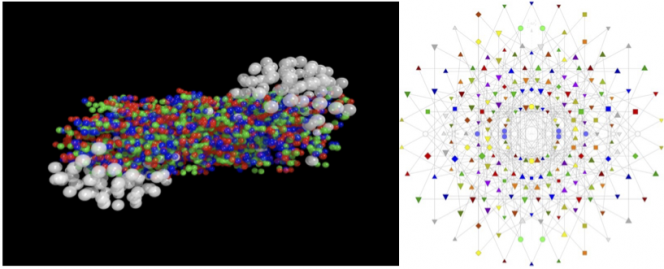Research in the Department of Physics in done in a variety of areas of experimental physics, theoretical physics, and astrophysics. Members of staff are involved in a number of different national and international research projects.
Maynooth University Department of Physics
ToggleAstronomical Instrumentation

Research in this area:
Condensed Matter Physics

Condensed matter physics is a study concerned with the phases of condensed matter, most familiar are the solid and liquid phases of matter. There are however more exotic phases that include Bose-Einstein condensates, magnetic phases and superconductivity. We study the general properties of topological phases (using topological field theory) as well as models of systems with anyons and experimentally accessible systems such as the two-dimensional electron liquids of the fractional quantum Hall effect.
Research in this area:
| Majorana fermions in condensed matter | Graham Kells |
| Topological phases in condensed matter | Joost Slingerland |
| Topological phases in lattice models | Jiri Vala |
Astrophysics and Cosmology

Researchers at the department work in may areas of astrophysics and cosmology including black holes, stars, galaxies, planets, the large scale structure and the cosmic microwave background. We use both ground-based observatories such as the ESO VLT, BISOU, and QUBIC, and space-based observatories such as JWST, HST, Spitzer, Euclid, XMM-Newton and Chandra. Many of our staff are involved in serveral large international projects including Euclid, LISA, JWST, BISOU and QUBIC.
Research in this area:
Indoor Environmental Physics

Our Indoor Environmental Physics research is dedicated to understanding the complex interactions between building physics, aerosol science, and human health. By applying experimental and computational approaches, we study the behaviour of airborne particles, airflow patterns and thermal dynamics to develop effective solutions for improving indoor environmental quality. Through interdisciplinary collaboration, we advance the science of the built environment and support healthier indoor spaces.
Research in this area:
| Indoor built environment | Dr James Mc Grath |
Atomic, Molecular and Optical Physics
Ongoing research at the department is involced electron impact ionisation and dissociation of molecules and clusters that are of interest to biophysics (radiation damage), atmospheric physics and other fields.
Research in this area:
| Molecular physics | Dr Peter J. M. van der Burgt |
| Quantum optics | Prof Ray O'Neill |
Quantum Field Theory and Particle Physics

Phenomenological and formal aspects of the Standard Model: strong interaction physics using nonperturbative methods (e.g. lattice gauge theory) and study of the symmetries of the Standard Model using mathematical methods (e.g. group theory).
Research in this area:
| Nonperturbative Quantum Field Theory | Jon-Ivar Skullerud |
| Symmetries beyond the Standard Model and elsewhere | Paul Watts |
Quantum Information and Computation
Quantum information science is the exploration of how quantum mechanical phenomena can be used to store, process and transmit information. It has the potential to revolutionize computing, cryptography, and communications via vastly more powerful computers and unbreakable encryption. Quantum information science is also revolutionising fundamental physics. It is providing new tools to understand complex systems in condensed matter physics, offering alternative perspectives on black hole physics and quantum gravity in cosmology, as well as new approaches to quantum foundations. Additionally, it's advancing precision measurement techniques and enabling simulations of previously inaccessible quantum phenomena.
Research in this area:
| Quantum algorithms and protocols | Jiri Vala |
| Quantum simulations | Graham Kells |
| Topological quantum computation | Joost Slingerland Jiri Vala |
| Quantum control and compilation | Jiri Vala |

